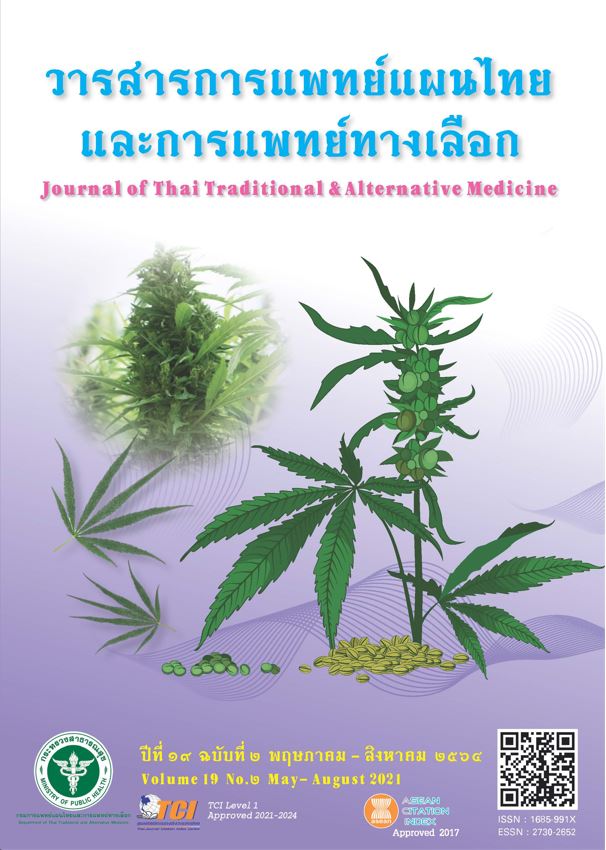การศึกษาคุณสมบัติทางเคมีกายภาพของไขมันสกัดจากเมล็ดโกโก้ และการใช้ประโยชน์ของไขมันโกโก้ทางยาและเครื่องสำอาง
Main Article Content
บทคัดย่อ
การศึกษานี้มีวัตถุประสงค์เพื่อศึกษาศักยภาพของการใช้เนยโกโก้ที่ผลิตในประเทศ โดยสกัดจากเมล็ดโกโก้ศึกษาคุณสมบัติทางเคมีกายภาพ และนำมาพัฒนาผลิตภัณฑ์เครื่องสำอางและยา ประเมินผลผลิตภัณฑ์ที่เตรียมได้ ผลการศึกษาพบว่า โกโก้พันธุ์ลูกผสม I.M.1 มีขนาดของฝักกว้างเฉลี่ย 7.43 เซนติเมตร และมีความยาวเฉลี่ย 13.44 เซนตเิ มตร น้ำหนักเฉลี่ยต่อฝัก 253.42 กรมั และมีจำนวนเมล็ด เฉลี่ยต่อฝัก 31.35 เมล็ด ให้เมล็ดที่สมบูรณ์ มีอัตราส่วนน้ำหนักเมล็ดโกโก้สดต่อน้ำหนักเมล็ดโกโก้แห้งเท่ากับ 3:1 ในการสกัดไขมันจากเมล็ดโกโก้ ได้เนยโกโก้ 33% (โดยน้ำหนัก) เมื่อศึกษาองค์ประกอบโดยวิธีแก๊สโครมาโทกราฟีด้วยเครื่อง GC-FID® พบวา่ กรดไขมันที่พบมากที่สุด คือ กรดสเตียริก (C18:0) ซึ่งมีปริมาณสูงถึง 37.47% และทำให้เกิดลักษณะทางกายภาพหรือความแข็งของเนยโกโก้ โดยกรดไขมันที่มีความสำคัญในด้านบำรุงผิวพรรณ ได้แก่ กรดโอเลอิก (35.22%) และ ไลโนเลอิก (2.78%) เนยโกโก้ มี 3 รูปผลึก คือ β (34.7˚C), β’ (27.8˚C) และ g (38˚C) โดยส่วนใหญ่อยู่ในรูป β ซึ่งคงตัวมากกว่ารูปผลึกอื่น ณ อุณหภูมิห้อง (28 ± 2˚C) ปริมาณพอลิฟีนอล ของเนยโกโก้ที่สกัดด้วยวิธีอัดเกลียว เท่ากับ 2.47 ± 0.04 (mg GAE/100g) ค่า IC50 เท่ากับ 0.12 ± 0.01 (mg/mL) และค่า TEAC มีค่า 72.61 ± 5.00 (mM Trolox/100g) เนยโกโก้ที่สกัดได้พัฒนาเป็นยาพื้นยาเหน็บทวารแอสไพริน มีลักษณะผิวภายนอกทีดี่ ผิวเรียบ ผ่าดูลักษณะภายใน ตัวยามีเนื้อกระจายสม่ำเสมอดี การแตกตัวอยู่ในเกณฑ์มาตรฐานคือ ไม่เกิน 30 นาที การเตรียมครีมโกโก้ โดยใช้ตัวทำอิมัลชัน ประเภทสบู่ สามารถเกิดครีมเนื้อเบา มีความคงตัวดี ทางกายภาพ ตลอดระยะเวลาศึกษาใน 6 สภาวะ ในระยะเวลา 3 เดือนที่ศึกษา การใช้ประโยชน์จากเนยโกโก้อาจต้องเติมสารต้านการหืนเนื่องจากเนยโกโก้ จะถูกออกซิไดส์ได้ง่าย และควรเก็บรักษาในที่เย็น ที่มืด ข้อเสนอแนะ การวิจัยต่อไป ควรวิเคราะห์ความคุ้มทุน ศึกษาการขยายการผลิต เพื่อให้มีเพียงพอต่อการใช้ในอนาคต โดยทดแทนเนยโกโก้ที่นำเข้าจากต่างประเทศ
Article Details
เอกสารอ้างอิง
Mcfadden C. Chocolate Bible. London: Lorenz books Publisher; 1999. 256 p.
Urquhart D.H. Cocoa. Kenya: Longmans Publisher; 1961. 293 p.
Laoongsri S. Textbook of Industrial crop; Pomology Division. Maejo University; 1999, 127 p. (in thai)
Tuncharoen K. Cocoa production and development. Department of Agricultural Extension; 2002. 93 p. (in
Thai)
Allen LV, Worthen DB, Mink B. Suppositories. Great Britain: The Pharmaceutical Press Publishing house;
245 p.
Lee KW, Kim YJ, Lee HJ, Lee CY. Cocoa has more phenolic phytochemicals and a higher antioxidant capacity than teas and red wine. J. Agric. Food Chem. 2003;51:7292-5
Nielson SS. Food analysis. 4th ed. New York: Springer Publishers; 2010. 602 p.
The United States Pharmacopeia 2011: USP 34; The national formulary: NF 29. Vol II. USA: United States
Pharmacopoeial Convention; 2010. 1934 p.
British Pharmacopoeia 2011. Vol I. Great Britain: British Pharmacopoeia, Stationery Office; 2010. p. 187.


